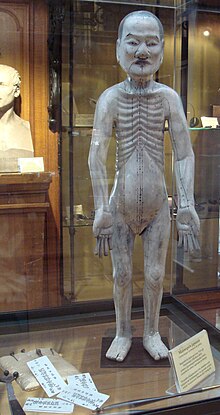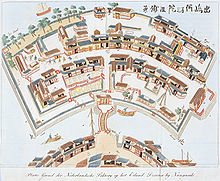Isaac Titsingh
Isaac Titsingh (born January 10, 1745 in Amsterdam , † February 2, 1812 in Paris ) was a Dutch scholar, merchant and ambassador.

Life
Titsingh came from a wealthy Amsterdam family who had produced several notable doctors. Probably for this reason he first studied medicine in Leiden, but then earned a doctorate in law and entered the service of the Dutch East India Company ( Vereenigde Oostindische Compagnie or VOC ) as a subcontractor ( onderkoopman ) in 1765, i.e. at the age of just twenty . In Batavia he initially worked in administration. In the summer of 1779 he sails to Japan for the first time and took over the management of the trading post, which he held with interruptions for a total of three and a half years. He traveled to Edo twice for audiences with the Shogun . Later he was governor general of the company in Chinsura , Bengal . Here he worked well with Charles Cornwallis , Governor General of the competing British East India Company . In 1795 Titsingh represented the interests of the Dutch in the Chinese Empire . At the court of Emperor Qianlong (also Chien-lung) he showed far more skill than the British ambassador Georges Macartney two years earlier.
Japan, 1779-1784
Three times Titsingh was head ( Opperhoofd , head of) the VOC office in Japan from August 1779 to November 1780, from August 1781 to November 1783 and from August 1784 to November 1784. Since the expulsion of the last Portuguese in 1639 were allowed in In the course of the Japanese policy of closure only the landing of the Dutch, who had to make do with the small artificial island Dejima (also written as “Deshima” in Western texts) in the bay of Nagasaki . Until the middle of the 19th century, Dejima functioned as a stage for Euro-Japanese trade and cultural exchange. Like his predecessors, Titsingh had to move once a year with his deputy, a secretary, the doctor of the branch and a large Japanese entourage to the court of the Shogun in Edo (today Tokyo) in order to express his gratitude to the company for the trade permit in Japan to affirm. Although contact with the population remained fairly limited on this “court trip to Edo” , the Europeans were able to observe the conditions in the interior of the country and, as far as the companions tolerated, collect materials and information. Japanese scholars, doctors and interested officials also took the opportunity to meet and exchange information. Almost all European doctors who took part in the court trip were also called to see high-ranking patients who showed their appreciation in many ways. During his time in Japan, the highly educated Titsingh got to know and appreciate influential sovereigns ( daimyō ) such as Shimazu Shigehide or Kutsuki Masatsuna and outstanding representatives of "Hollandkunde" ( Rangaku ) such as Katsuragawa Hoshū or Nakagawa Jun'an . The collection that he brought together despite all the prohibitions and smuggled out of the country documents Titsingh's ambitions as well as his skills in dealing with Japanese partners.
India, 1785–1792
In 1785 Titsingh was appointed director of the VOC trading post in Chinsura , Bengal . Chinsura lies upstream from Calcutta on the Hugli River , a tributary of the Ganges . Titsingh appears to have stimulated the intellectual life of the European community. By William Jones , a philologist and lawyers in Calcutta, he has been called "the Mandarin described by Chinsura".
Batavia, 1792-1793
Titsingh's return to Batavia (now Jakarta , Indonesia ) led to new responsibilities as Ontvanger-Generaal (treasurer) and later as Commisaris ter Zee (sea commissioner).
China, 1794-1795
For the celebrations of the sixtieth anniversary of the reign of Emperor Qianlong (1711–1799) Titsingh was appointed Dutch ambassador to China. The Dutch delegation included a. Andreas Everardus van Braam Houckgeest and Chrétien-Louis-Joseph de Guignes . Its reports have been published in both Europe and the USA .
Europe, 1796-1812
After decades in East Asia, Titsingh returned to Europe and eventually settled in Paris. His collection, the “Cabinet Titsingh”, caused a sensation. He was actually planning a comprehensive description of Japan, which should replace the previous standard works by Engelbert Kaempfer and Carl Peter Thunberg . However, this undertaking did not materialize. Titsingh died on February 2, 1812 and was buried in the Père-Lachaise cemetery. The headstone was inscribed with the following inscription: “Ici repose Isaac Titsingh. Ancien conseiller des Indes hollandaises. Ambassador à la Chine et au Japon. Mort à Paris le 2 Février 1812, âgé de 68 ans. ”(Here lies Isaac Titsingh, former councilor of the Dutch East India Company, ambassador to China and Japan, died in Paris on February 2, 1812, at the age of 68. )
Contribution to the exploration of Japan
After his death, Titsingh's “Cabinet” was supposed to go to England, but after all sorts of confusion the objects came into the hands of the Parisian publisher Auguste Nicolas Nepveu in 1818 . It took him five years to publish some of Titsingh's essays under the title Cérémonies usitées au Japon, pour les mariages et les funérailles: suivies de détails sur la poudre Dosia, de la préface d'un livre de Confoutzée sur la piété filiale . Then the orientalist Jean Pierre Abel-Rémusat (1788–1832) sifted through the estate. The Mémoires et anecdotes sur la dynastie régnante des Djogouns, souverains du Japon (1820), edited by him , a bundle of various treatises by Titsingh, were welcomed, soon translated into English and then even into Dutch. Abel-Rémusat, who could only read Chinese text, won Heinrich Julius Klaproth (1783–1835) to collaborate. Klaproth received a salary as a professor for Asian languages at Berlin University, but lived in Paris with the permission of the Prussian king. In 1834 he published the Nipon O Daï Itsi Ran, ou Annales des Empereurs du Japan, traduites par Isaac Titsingh, avec l'aide de plusieurs interprètes attachés au comptoir hollandais de Nagasaki , a translation of the Japanese chronicle Nihon Ōdai Ichiran . Nepveu went bankrupt in 1828 and the "Cabinet Titsingh" was scattered to the wind. Shortly afterwards, after a long stay in Japan , Philipp Franz von Siebold (1796–1866) brought his treasures to Europe, which overshadowed everything that had come before, so that Titsingh's collection was soon forgotten.
Works
- Cérémonies usitées au Japon pour les mariages et les funérailles. Paris: Nepveu, 1819. (( online ) at books.google.com)
- Mémoires et Anecdotes sur la Dynastie régnante des Djogouns, Souverains du Japon, avec la description des fêtes et cérémonies observées aux différentes époques de l'année à la Cour de ces Princes, et un appendice contenant des détails sur la poésie des manière, leur de diviser l'année, etc .; Ouvrage orné de Planches gravées et coloriées, tiré des Originaux Japonais by M. Titsingh; publié avec des Notes et Eclaircissemens Par M. Abel-Rémusat . Paris (Nepveu), 1820. (( online ) at books.google.com (French))
- Illustrations of Japan; consisting of Private Memoirs and Anecdotes of the reigning dynasty of The Djogouns, or Sovereigns of Japan; a description of the Feasts and Ceremonies observed throughout the year at their Court; and of the Ceremonies customary at Marriages and Funerals: to which are subjoined, observations on the legal suicide of the Japanese, remarks on their poetry, an explanation of their mode of reckoning time, particulars respecting the Dosia powder, the preface of a work by Confoutzee on filial piety, & c. & c. by M. Titsingh formerly Chief Agent to the Dutch East India Company at Nangasaki. Translated from the French, by Frederic Shoberl with colored plates, faithfully copied from Japanese original designs. London (Ackermann), 1822.
- Describing from het naadle steeken en moxa branden. Netherlands 1827. In addition: A letter dated September 19, 1827 from Heinrich Julius Klaproth (1783–1835) to Jean-Baptiste Sarlandière . (Digitized version)
- Translation: [Siyun-sai Rin-siyo / Hayashi Gahō (1652)]. Nipon o daï itsi ran [Nihon Ōdai Ichiran] or Annales des empereurs du Japon , tr. Par M. Isaac Titsingh avec l'aide de plusieurs interprètes attachés au comptoir hollandais de Nangasaki; ouvrage right, complété et cor. sur l'original japonais-chinois, accompagné de notes et précédé d'un Aperçu d'histoire mythologique du Japon, par M. J. Klaproth . Paris, 1834. ( online at books.google.com (English))
further reading
- de Guignes, C.-L.-J. (1808). Voyage a Pékin, Manille et l'Ile de France. Paris.
- Duyvendak, JJL (1937). "The Last Dutch Embassy to the Chinese Court (1794-1795)." T'oung Pao 33: 1-137.
- Jones, W. (1835). Memoirs of the life, writings and correspondence of Sir William Jones, by Lord Teignmouth. London.
- Lequin, F. (2005). Isaac Titsingh in China (1794-1796). Alphen aan den Rijn.
- Lequin, F. (2002). Isaac Titsingh (1745-1812): een passie voor Japan, leven en werk van de grondlegger van de Europese Japanologie . Suffer.
- Lequin, F. (Eds.) (1990-92). The Private Correspondence of Isaac Titsingh. Amsterdam. * Leguin, F. (2002).
- Nederland's Patriciaat, Vol. 13 (1923). The hague.
- O'Neil, Patricia O. (1995). Missed Opportunities: Late 18th Century Chinese Relations with England and the Netherlands. (Ph.D. dissertation, University of Washington).
- Screech, Timon. (2006). Secret Memoirs of the Shoguns: Isaac Titsingh and Japan, 1779-1822. London.
- van Braam Houckgeest, AE (1797). Voyage de l'ambassade de la Compagnie des Indes Orientales hollandaises vers l'empereur de la Chine, dans les années 1794 et 1795. Philadelphia; _____. (1798). An authentic account of the embassy of the Dutch East-India Company, to the court of the emperor of China, in the years 1794 and 1795. London.
- Wolfgang Michel, Torii Yumiko, Kawashima Mabito: Kyūshū no rangaku - ekkyō to kōryū (= Dutch customer in Kyushu - border crossing and exchange). Shibunkaku Shuppan, Kyōto, 2009. ISBN 978-4-7842-1410-5
Web links
- Literature by and about Isaac Titsingh in the catalog of the German National Library
Individual evidence
- ↑ A picture of this doll showing the therapy points for acupuncture and moxibustion was published in Jean-Baptiste Sarlandières Mémoires sur l'électro-puncture (1825).
- ^ Pouillon, François. (2008). Dictionnaire des orientalistes de langue française, p. 542 .
| personal data | |
|---|---|
| SURNAME | Titsingh, Isaac |
| BRIEF DESCRIPTION | Dutch surgeon, scholar, merchant and ambassador |
| DATE OF BIRTH | January 10, 1745 |
| PLACE OF BIRTH | Amsterdam |
| DATE OF DEATH | February 2, 1812 |
| Place of death | Paris |

